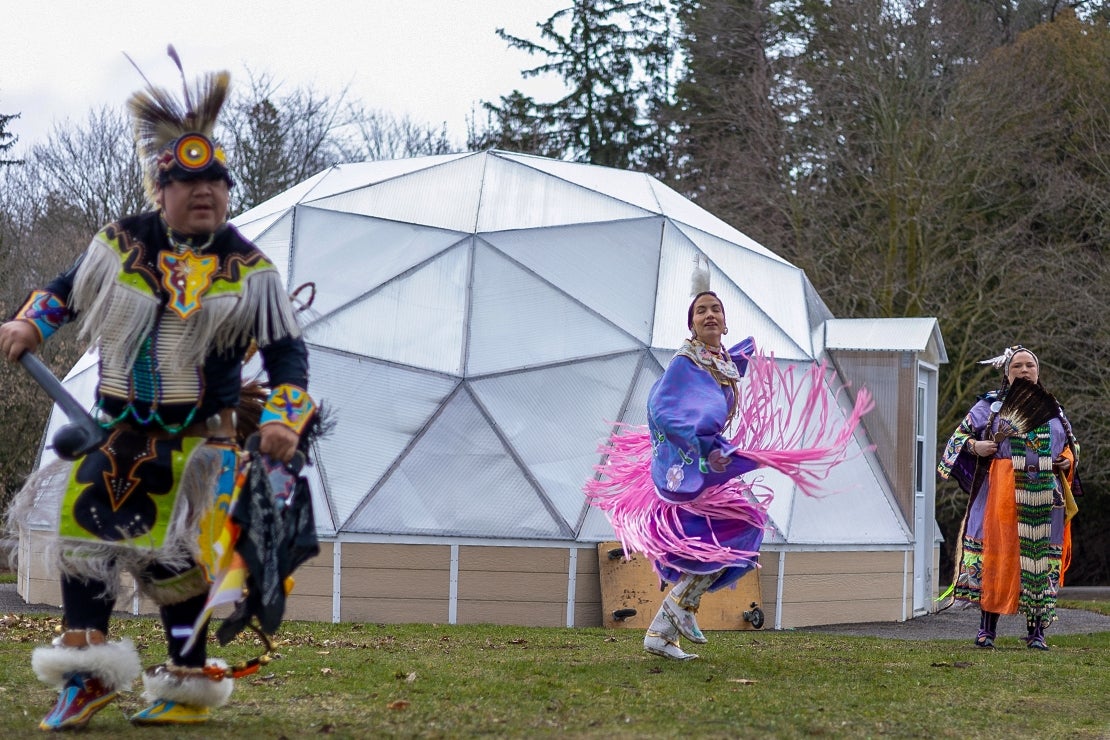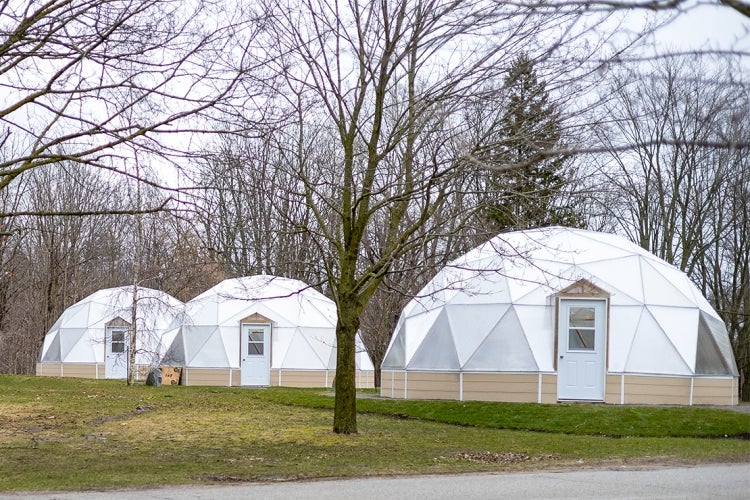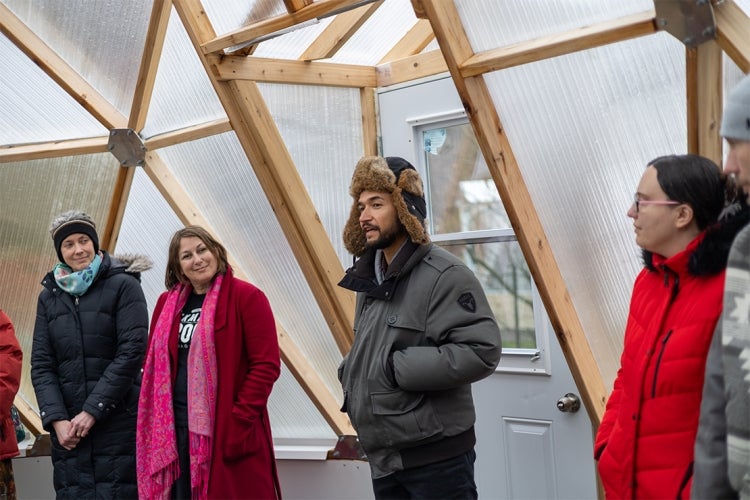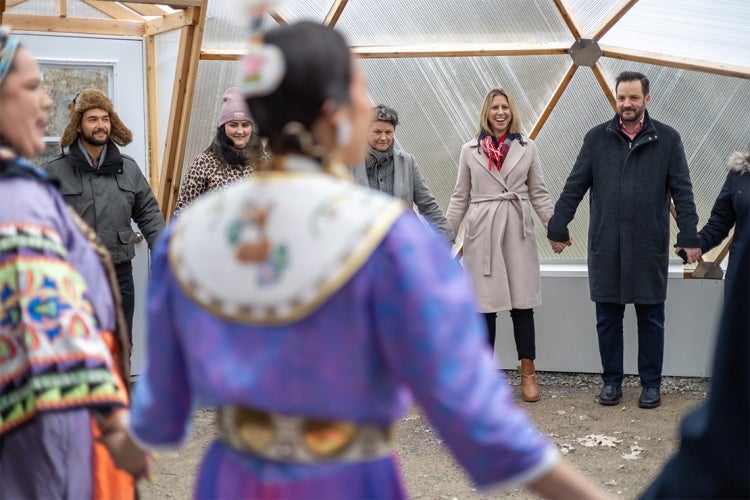
From The University of Toronto-Scarborough (CA)
4.25.24
Alexa Battler
Photos by Junyoung Moon
The domes, located at U of T Scarborough, are being constructed as part of the Indigenous Entrepreneurship and Garden Project.

(From left) Lindy Kinoshameg, Jillian Sutherland and Leslie McCue from the dance group Odawa Wiingushk performed at an opening ceremony for the Indigenous Entrepreneurship and Garden Project
Four 24-foot domes resembling giant golf balls have been erected beside the tennis courts in the Highland Creek Valley at the University of Toronto Scarborough – high-tech greenhouses equipped with solar panels, irrigation systems and geothermal tubes that run deep underground.
The domes were constructed as part of the Indigenous Entrepreneurship and Garden Project, an initiative that aims to offer a hands-on complement to the Indigenous Entrepreneurship Workshops, which begin this September and are designed to help students and community members connect Indigenous knowledge, community and entrepreneurship.
The workshops were co-created – and will be taught – by Jonathon Araujo Redbird, a business leader from Saugeen First Nation who runs Redbird Circle Inc., a company specializing in entrepreneurship training based on Indigenous knowledges and values. They’re being offered in partnership with U of T Scarborough’s The BRIDGE and U of T Mississauga’s ICUBE accelerators.
“We want Indigenous youth to come here and make it their second home and learn about the land, how to grow produce from the land and how we can learn entrepreneurship through that process,” says Redbird, who co-founded Redbird Circle with Christina Tachtampa.

The four domes are connected both physically – through an accessible pathway – and thematically
Redbird Circle first partnered with ICUBE in 2021 to offer the Indigenous Entrepreneurship Program. The company then collaborated with the Indigenous Network non-profit to bring the idea of a garden project to life, with the help of a grant from the Canada Community Revitalization Fund.
The series comprises a free, virtual 12-week program modelled on the medicine wheel – an Indigenous symbol of balance between physical, mental, emotional and spiritual well-being.
The medicine wheel also inspired the themes for the domes, which are interconnected and will stay at a humid 35 degrees C year-round.
The first dome will be dedicated to growing crops that support wellness, while the second will be used to test ways to rejuvenate soil without using chemicals. The third dome will be used to teach entrepreneurship through crops and to find ways to turn produce into high-yield sources of income for Indigenous people and communities.
Finally, dome four will be devoted to experimenting with agriculture technologies, starting with vertical farming equipment made by U of T startup Just Vertical.
All four domes will be accessible for people using mobility devices and entirely self-sustaining when construction finishes in the coming months.

Jonathon Araujo Redbird (centre) spoke to community members at the opening ceremony in April
Redbird, who grew up in the Gabriel Dumont housing complex in Scarborough, says he has experienced how difficult it can be for Indigenous people to stay connected to the land on urban reserves. He adds Indigenous people face an added obstacle to building intergenerational wealth in the form of the Indian Act, which he says makes it challenging to borrow money and impossible to trade land with people outside their communities.
“If Indigenous people want to build intergenerational wealth, the only way to do that is to leave our traditional lands and come to the cities,” he says. “And when we do come to the cities, the prices are very high to purchase a home.”
But Redbird says entrepreneurial thinking can play a role in empowering Indigenous people, with agriculture providing one important avenue.
While the workshop series is designed for Indigenous learners, it is open to anyone interested in traditional Indigenous knowledge and entrepreneurship, with community members encouraged to share their thoughts on how they envision the domes’ layouts and uses.

The opening ceremony invited local community members to give their feedback on their visions for the domes
“This is a space that’s very much been created and will continue to be improved upon through that consultative approach and listening to community feedback,” says Arjuna Thaskaran, industry partnerships, innovation and work-integrated learning lead at The BRIDGE. “It’s about having the community take ownership of the space and drive how they want to shape it.”
Various academic departments have expressed interest in collaborating on the program. “There are discussions with several programs about Indigenizing some of the current projects and curriculum, and learning about sustainability through Indigenous approaches to urban agriculture,” says Dave Fenton, assistant director of external relations in U of T Scarborough’s department of management.
See the full article here.
Comments are invited and will be appreciated, especially if the reader finds any errors which I can correct.
five-ways-keep-your-child-safe-school-shootings
Please help promote STEM in your local schools.
The University of Toronto-Scarborough, is one of the three campuses that make up the tri-campus system of the University of Toronto. Located in the Scarborough district, Toronto, Ontario, Canada, the campus is set upon suburban parkland next to Highland Creek. It was established in 1964 as Scarborough College, a constituent college of the Faculty of Arts and Science. The college expanded following its designation as an autonomic division of the university in 1972 and gradually became an independent institution. It ranks last in area and enrollment size among the three University of Toronto campuses, the other two being the St. George campus in Downtown Toronto and the University of Toronto Mississauga.
Academics of the campus are centered on a variety of undergraduate studies in the disciplines of management, arts and sciences, whilst also hosting limited postgraduate research programs. Its neuroscience program was the first to be offered in the nation. The campus is noted for being the university’s sole provider of cooperative education programs, as well as the Bachelor of Business Administration degree. Through affiliation with the adjacent Centennial Science and Technology Centre of Centennial College, it also offers enrollment in joint programs.
The campus has traditionally held the annual F. B. Watts Memorial Lectures, which has hosted internationally renowned scholars since 1970. Its nuclear magnetic resonance laboratory was the first of its kind in Canada, allowing the campus to conduct influential research in the environmental sciences. The original building of the campus was internationally acclaimed for its architectural design. The Dan Lang Field, home to the baseball team of the Toronto Varsity Blues, is also situated at the campus.
The 152-hectare (380-acre) land along the valley of the Highland Creek was purchased in 1911 by Toronto-based businessman Miller Lash, who developed the site into his summer estate with a mansion, today known as the Miller Lash House. The mansion included 17 rooms, a barn, a coach house, and three houses for his staff to dwell. Over the following years, over 100 acres of the estate was also used as farmland. Following the death of Miller Lash in 1941, the estate was acquired by E. L. McLean, an insurance broker, in 1944 for $59,000. He made new additions to the estate, including a swimming pool and change room, and a retaining wall made in stone.
About 82 hectares (200 acres) of property was later purchased from McLean, just before his death, by the University of Toronto for about $650,000 in 1963, as part of the university’s regional expansion. The groundskeeper of the land would continue to reside in the Highland Creek valley for the next 29 years. McLean’s additions to the Miller Lash House, which would eventually become the residence of the campus’s principal, were modernized and 28 hectares (70 acres) of surrounding land north of the estate were also acquired. The University of Toronto established the Scarborough College as part of the institution’s collegiate university system and declared the campus a branch of the Faculty of Arts and Science. D. C. Williams was appointed as the principal of Scarborough College and the planned Erindale College, as well as vice-president of the university. The college’s faculty, consisting of 16 members, was also established and headquartered at the main campus in Downtown Toronto. First classes were held at Birchmount Park Collegiate Institute and Old Biology Building at the St. George campus. Designed by John Andrews, the first building of the campus began construction the following year. Due to delays in construction after a strike among workers, the Scarborough College opened in temporary classes at the main campus to 191 full-time students in 1965. The first building was completed in time for the following academic year.
The college included a 6,000-square-foot (560 m^2) television production studio. This was for a unique video lecturing system the college was initially planned to have, that relies on the use of closed-circuit television for teaching purposes. The system grabbed international media attention, and was complimented in the 1967 edition of Time. However, the video lecturing system was abandoned after it was condemned for the lack of communicability of students with instructors. In 1972, the campus was reorganized as a separately governed division of the university’s Faculty of Arts and Science, developing its own curriculum. In 1973, it became the first post-secondary institution to adopt a course credit system in Ontario and the first cooperative education program was established. The campus adopted its present official name in 2006 after being renamed University of Toronto Scarborough Campus in 1983 and University of Toronto at Scarborough in 1996. The initials UTSC comes from the former name and continue to be used by the university to distinguish the campus from University of Toronto Schools (UTS).
The University of Toronto (CA) is a public research university in Toronto, Ontario, Canada, located on the grounds that surround Queen’s Park. It was founded by royal charter in 1827 as King’s College, the oldest university in the province of Ontario.
Originally controlled by the Church of England, the university assumed its present name in 1850 upon becoming a secular institution.
As a collegiate university, it comprises eleven colleges each with substantial autonomy on financial and institutional affairs and significant differences in character and history. The university also operates two satellite campuses located in Scarborough and Mississauga.
The University of Toronto has evolved into Canada’s leading institution of learning, discovery and knowledge creation. We are proud to be one of the world’s top research-intensive universities, driven to invent and innovate.
Our students have the opportunity to learn from and work with preeminent thought leaders through our multidisciplinary network of teaching and research faculty, alumni and partners.
The ideas, innovations and actions of more than 600,000 graduates continue to have a positive impact on the world.
Academically, The University of Toronto is noted for movements and curricula in literary criticism and communication theory, known collectively as the “Toronto School”.
The university was the birthplace of insulin and stem cell research, and was the site of the first electron microscope in North America; the identification of the first black hole Cygnus X-1; multi-touch technology, and the development of the theory of NP-completeness.
The university was one of several universities involved in early research of deep learning. It receives the most annual scientific research funding of any Canadian university and is one of two members of the Association of American Universities outside the United States, the other being McGill University [Université McGill] (CA) .
The Varsity Blues are the athletic teams that represent the university in intercollegiate league matches, with ties to gridiron football, rowing and ice hockey. The earliest recorded instance of gridiron football occurred at University of Toronto’s University College in November 1861.
The university’s Hart House is an early example of the North American student centre, simultaneously serving cultural, intellectual, and recreational interests within its large Gothic-revival complex.
The University of Toronto has educated Governors General of Canada, Prime Ministers of Canada, foreign leaders, and Justices of the Supreme Court. Nobel laureates, Turing Award winners, Rhodes Scholars, and Fields Medalists have been affiliated with the university.
Early history
The founding of a colonial college had long been the desire of John Graves Simcoe, the first Lieutenant-Governor of Upper Canada and founder of York, the colonial capital. As a University of Oxford (UK)-educated military commander who had fought in the American Revolutionary War, Simcoe believed a college was needed to counter the spread of republicanism from the United States. The Upper Canada Executive Committee recommended in 1798 that a college be established in York.
On March 15, 1827, a royal charter was formally issued by King George IV, proclaiming “from this time one College, with the style and privileges of a university … for the education of youth in the principles of the Christian Religion, and for their instruction in the various branches of Science and Literature … to continue forever, to be called King’s College.” The granting of the charter was largely the result of intense lobbying by John Strachan, the influential Anglican Bishop of Toronto who took office as the college’s first president. The original three-story Greek Revival school building was built on the present site of Queen’s Park.
Under Strachan’s stewardship, King’s College was a religious institution closely aligned with the Church of England and the British colonial elite, known as the “Family Compact”. Reformist politicians opposed the clergy’s control over colonial institutions and fought to have the college secularized. In 1849, after a lengthy and heated debate, the newly elected responsible government of the Province of Canada voted to rename King’s College as the University of Toronto and severed the school’s ties with the church. Having anticipated this decision, the enraged Strachan had resigned a year earlier to open Trinity College as a private Anglican seminary. University College was created as the nondenominational teaching branch of the University of Toronto. During the American Civil War, the threat of Union blockade on British North America prompted the creation of the University Rifle Corps which saw battle in resisting the Fenian raids on the Niagara border in 1866. The Corps was part of the Reserve Militia lead by Professor Henry Croft.
Established in 1878, the School of Practical Science was the precursor to the Faculty of Applied Science and Engineering which has been nicknamed “Skule” since its earliest days. While the Faculty of Medicine opened in 1843 medical teaching was conducted by proprietary schools from 1853 until 1887 when the faculty absorbed the Toronto School of Medicine. Meanwhile the university continued to set examinations and confer medical degrees. The university opened the Faculty of Law in 1887, followed by the Faculty of Dentistry in 1888 when the Royal College of Dental Surgeons became an affiliate. Women were first admitted to the university in 1884.
A devastating fire in 1890 gutted the interior of University College and destroyed 33,000 volumes from the library but the university restored the building and replenished its library within two years. Over the next two decades a collegiate system took shape as the university arranged federation with several ecclesiastical colleges including Strachan’s Trinity College in 1904. The university operated the Royal Conservatory of Music from 1896 to 1991 and the Royal Ontario Museum from 1912 to 1968; both still retain close ties with the university as independent institutions. The University of Toronto Press was founded in 1901 as Canada’s first academic publishing house. The Faculty of Forestry founded in 1907 with Bernhard Fernow as dean was Canada’s first university faculty devoted to forest science. In 1910, the Faculty of Education opened its laboratory school, the University of Toronto Schools.
World wars and post-war years
The First and Second World Wars curtailed some university activities as undergraduate and graduate men eagerly enlisted. Intercollegiate athletic competitions and the Hart House Debates were suspended although exhibition and interfaculty games were still held. The David Dunlap Observatory in Richmond Hill opened in 1935 followed by the University of Toronto Institute for Aerospace Studies in 1949. The university opened satellite campuses in Scarborough in 1964 and in Mississauga in 1967. The university’s former affiliated schools at the Ontario Agricultural College and Glendon Hall became fully independent of the University of Toronto and became part of University of Guelph (CA) in 1964 and York University (CA) in 1965 respectively. Beginning in the 1980s reductions in government funding prompted more rigorous fundraising efforts.
Since 2000
In 2000 Kin-Yip Chun was reinstated as a professor of the university after he launched an unsuccessful lawsuit against the university alleging racial discrimination. In 2017 a human rights application was filed against the University by one of its students for allegedly delaying the investigation of sexual assault and being dismissive of their concerns. In 2018 the university cleared one of its professors of allegations of discrimination and antisemitism in an internal investigation after a complaint was filed by one of its students.
The University of Toronto was the first Canadian university to amass a financial endowment greater than C$1 billion in 2007. On September 24, 2020 the university announced a C$250 million gift to the Faculty of Medicine from businessman and philanthropist James C. Temerty- the largest single philanthropic donation in Canadian history. This broke the previous record for the school set in 2019 when Gerry Schwartz and Heather Reisman jointly donated C$100 million for the creation of a 750,000-square foot innovation and artificial intelligence centre.
Research
Since 1926 the University of Toronto has been a member of the Association of American Universities a consortium of the leading North American research universities. The university manages by far the largest annual research budget of any university in Canada with sponsored direct-cost expenditures of over C$900 million. The University of Toronto has been named the top research university in Canada by Research Infosource with annual sponsored research income (external sources of funding) of C$1.2 billion. The university’s faculty averaged a sponsored research income of C$500,000 while graduate students averaged a sponsored research income of C$64,000. The federal government was the largest source of funding with grants from the Canadian Institutes of Health Research; the Natural Sciences and Engineering Research Council; and the Social Sciences and Humanities Research Council amounting to about one-third of the research budget. About eight percent of research funding came from corporations- mostly in the healthcare industry.
The first practical electron microscope was built by the physics department in 1938. During World War II the university developed the G-suit- a life-saving garment worn by Allied fighter plane pilots later adopted for use by astronauts. Development of the infrared chemiluminescence technique improved analyses of energy behaviors in chemical reactions. In 1963 the asteroid 2104 Toronto was discovered in the David Dunlap Observatory (CA) in Richmond Hill and is named after the university. In 1972 studies on Cygnus X-1 led to the publication of the first observational evidence proving the existence of black holes. Toronto astronomers have also discovered the Uranian moons of Caliban and Sycorax; the dwarf galaxies of Andromeda I, II and III; and the supernova SN 1987A. A pioneer in computing technology the university designed and built UTEC- one of the world’s first operational computers- and later purchased Ferut- the second commercial computer after UNIVAC I. Multi-touch technology was developed at Toronto with applications ranging from handheld devices to collaboration walls. The AeroVelo Atlas which won the Igor I. Sikorsky Human Powered Helicopter Competition in 2013 was developed by the university’s team of students and graduates and was tested in Vaughan.
The discovery of insulin at The University of Toronto in 1921 is considered among the most significant events in the history of medicine. The stem cell was discovered at the university in 1963 forming the basis for bone marrow transplantation and all subsequent research on adult and embryonic stem cells. This was the first of many findings at Toronto relating to stem cells including the identification of pancreatic and retinal stem cells. The cancer stem cell was first identified in 1997 by Toronto researchers who have since found stem cell associations in leukemia, brain tumors, and colorectal cancer. Medical inventions developed at Toronto include the glycaemic index, the infant cereal Pablum, the use of protective hypothermia in open heart surgery and the first artificial cardiac pacemaker. The first successful single-lung transplant was performed at Toronto in 1981 followed by the first nerve transplant in 1988 and the first double-lung transplant in 1989. Researchers identified the maturation promoting factor that regulates cell division and discovered the T-cell receptor which triggers responses of the immune system. The university is credited with isolating the genes that cause Fanconi anemia, cystic fibrosis and early-onset Alzheimer’s disease among numerous other diseases. Between 1914 and 1972 the university operated the Connaught Medical Research Laboratories- now part of the pharmaceutical corporation Sanofi-Aventis. Among the research conducted at the laboratory was the development of gel electrophoresis.
The University of Toronto is the primary research presence that supports one of the world’s largest concentrations of biotechnology firms. More than 5,000 principal investigators reside within 2 kilometres (1.2 mi) from the university grounds in Toronto’s Discovery District conducting C$1 billion of medical research annually. MaRS Discovery District is a research park that serves commercial enterprises and the university’s technology transfer ventures. The university has patented many inventions and has been involved with many active start-up companies. Its SciNet Consortium operates the most powerful supercomputer in Canada.


